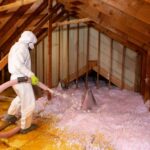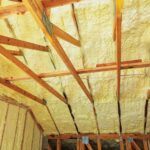Windstorms can cause significant damage to rooftops, and knowing how to handle roof damage from wind is critical for homeowners. Understanding the steps to repair and maintain your roof will help prevent further issues and protect your investment.

Understanding Wind-Related Roof Damage
Wind can be a powerful force that leads to common roofing problems such as missing shingles, leaks, and structural damage. It’s important to identify these issues early to mitigate the risk of extensive repairs.
Types of Wind-Related Damage
There are various types of damage caused by wind, including:
- Missing or damaged shingles: Strong winds can dislodge shingles, leaving your roof vulnerable to leaks.
- Dented or displaced flashing: High winds can damage the metal pieces that protect roof joints.
- Structural damage: Severe storms may cause more extensive damage to the framework of your roof.
Steps to Inspect Your Roof After a Windstorm
Before making any repairs, a thorough inspection is necessary. Here’s how to safely inspect your roof:
Safety Precautions
Always prioritize safety when inspecting your roof. Use a stable ladder, wear proper footwear, and consider hiring a professional if the damage is extensive.
Signs to Look For
During your inspection, look for signs such as:
- Missing or broken shingles
- Damage around the chimney or roof edges
- Water stains or leaks inside your home
Repairing Wind Damage
Once you’ve identified the problem areas, it’s time to address the damage.
Replacing Shingles
If you find missing or damaged shingles, they should be replaced promptly to prevent leaks. Follow these steps:
- Remove damaged shingles carefully.
- Install new shingles securely.
- Ensure proper alignment with existing shingles.
Fixing Flashing
Repair or replace any damaged flashing to avoid water entry.
Preventive Measures for Future Windstorms
Taking preventive measures can minimize the risk of wind damage in the future.
Regular Maintenance
Perform regular maintenance by checking your roof at least twice a year to catch potential issues early.
Installing Wind-Resistant Shingles
Consider installing shingles designed to withstand high winds for added protection.
When to Call a Professional
If the damage is extensive or if you’re uncomfortable performing repairs yourself, it’s best to call a professional.
Benefits of Hiring a Professional
Professionals offer expertise, ensuring repairs are done correctly and safely.
Insurance and Roof Damage
Understanding your homeowner’s insurance policy is crucial in handling roof repairs after a windstorm.
Filing an Insurance Claim
Document all damage and consult with your insurance company to file a claim.
Protect Your Investment
By understanding how to handle roof damage from wind, you protect your home and prolong the life of your roof. Stay proactive and informed to prevent future issues.

FAQs
What should I look for when inspecting my roof?
Look for missing shingles, damaged flashing, and signs of leaks.
Can I repair wind damage myself?
Minor repairs can be handled by homeowners, but extensive damage should be assessed by a professional.
How often should I inspect my roof?
Inspect your roof at least twice a year or after significant weather events.
For comprehensive roof maintenance tips, consider visiting this guide. For additional advice on roof inspections, check out our in-depth article on roof inspection.
This article contains affiliate links. We may earn a commission at no extra cost to you.







